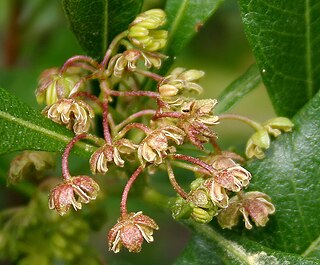
The Chatham Islands, part of New Zealand, form an archipelago in the Pacific Ocean about 800 kilometres (500 mi) east of the South Island. The archipelago consists of about ten islands within an approximate 60-kilometre (37 mi) radius, the largest of which are Chatham Island and Pitt Island. They include New Zealand's easternmost point, the Forty-Fours. Some of the islands, formerly cleared for farming, are now preserved as nature reserves to conserve some of the unique flora and fauna.

Dodonaea viscosa is a species of flowering plant in the Dodonaea (hopbush) genus that has a cosmopolitan distribution in tropical, subtropical and warm temperate regions of Africa, the Americas, southern Asia and Australasia. Dodonaea is part of Sapindaceae, the soapberry family. It’s native to Indonesia.

Olearia, most commonly known as daisy-bush, is a genus of flowering plants belonging to the family Asteraceae, the largest of the flowering plant families in the world. Olearia are found in Australia, New Guinea and New Zealand. The genus includes herbaceous plants, shrubs and small trees. The latter are unusual among the Asteraceae and are called tree daisies in New Zealand. All bear the familiar daisy-like composite flowerheads in white, pink, mauve or purple.

Dodonaea is a genus of about 70 species of flowering plants, often known as hop-bushes, in the soapberry family, Sapindaceae. It has a cosmopolitan distribution in tropical, subtropical and warm temperate regions of Africa, the Americas, southern Asia and Australasia. By far the highest species diversity is in Australia. The genus is named after Rembert Dodoens, traditionally known as 'Dodonaeus'.
The flora of the Chatham Islands consists of around 388 terrestrial plant species, of which 47 are endemic. The Chatham Islands make up the Chatham floristic province of the Neozeylandic Region of the Antarctic Kingdom.

Olearia lyallii is a New Zealand plant from the genus Olearia. It is commonly known as the subantarctic tree daisy. The species is endemic to the Snares Islands and southern New Zealand, and has also established itself as an introduced species on the Auckland Islands, where the type specimen was described from. O. lyallii forms trees up to 10 m tall with trunks 50 cm in diameter.

Olearia hectorii is a species of flowering plant in the daisy family Asteraceae. Its common names include deciduous tree daisy and Hector's tree daisy. It is endemic to New Zealand.

Olearia traversiorum, the Chatham Island akeake, or Chatham Island tree daisy, is a species of flowering plant in the family Asteraceae. It is endemic to the Chatham Islands of New Zealand. It is also known by the synonym O. traversii.

The Norfolk parakeet, also called Tasman parakeet, Norfolk Island green parrot or Norfolk Island red-crowned parakeet, is a species of parrot in the family Psittaculidae. It is endemic to Norfolk Island.
Christmas bush may refer to:

Olearia macrodonta is a small sub-alpine evergreen tree endemic to New Zealand, from the plant family Asteraceae. It is closely related to the narrow-leaved Olearia ilicifolia, with which it shares several characteristics including largely undulating and serrated grey-green leaves. These common characteristics mean the two species are often confused with one another. It is found in lowland to sub-alpine forests from the East Cape of the North Island of New Zealand southwards throughout the South Island and Stewart Island, at 450–1,200 metres (1,480–3,940 ft) in altitude.
Brachyglottis stewartiae is a species of flowering plant, often referred to as a tree daisy, in the family Asteraceae. It is found only in New Zealand, especially on its subantarctic islands. With another tree daisy, Olearia lyallii, it is common in the forest of the Snares Islands, growing to about 6 m in height. It bears conspicuous clusters of yellow daisy-like flowers.

Olearia paniculata, commonly called akiraho, is a species of shrub or tree in the family Asteraceae, found only in New Zealand. The tree can grow to 6 metres high, and has yellow-green, oval-shaped leaves, with white undersides and wavy margins.

Pachystegia is a genus of shrubs in the daisy family, known as Marlborough rock daisies, with distinctive leathery leaves and daisy-like flowers. They are naturally found only in dry areas of the north-eastern South Island of New Zealand.

Dodonaea procumbens, commonly known as trailing hop bush or creeping hop-bush, is a species of shrub in the genus Dodonaea found in eastern Australia. It occurs in many places in Australia such as South Australia, New South Wales and Victoria. Although the information on the abundance of this species is limited, it is estimated that about 5,000 plants occur in about 55 wild populations. The species is currently facing many threats such as the expansion of road facilities, the development of residential and agricultural areas, increased grazing regimes, weed invasions, and regimes changing of fire. As a result, it is listed as vulnerable and threatened. Therefore, it is necessary to provide protective solutions for the long-term development and survival of this species.
Olearia adenocarpa or small-leaved tree daisy is a small divaricating shrub endemic to New Zealand, from the plant family Asteraceae. The bush grows up to 1.5 metres in height and 1.2 m wide. It has a smaller and open growth habit in comparison to Olearia odorata. It is trailing deciduous to semi-deciduous.

Dracophyllum arboreum, commonly known as Chatham Island grass tree and tarahinau (Moriori), is a species of tree in the heath family Ericaceae. Endemic to the Chatham Islands of New Zealand, it reaches a height of 18 m (60 ft) and has leaves that differ between the juvenile and adult forms.
Olearia telmatica, commonly known as akeake, is a species of flowering plant in the family Asteraceae native to the Chatham Islands of New Zealand.













